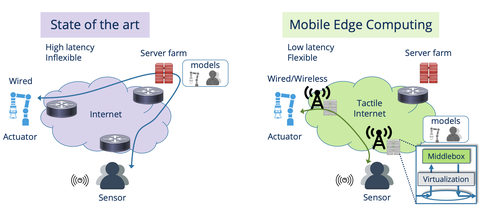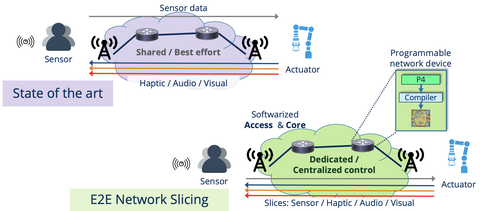Research fields
Our research focuses on the interplay between communications and computing for In-Network Computing. The goal is to develop flexible, resilient, and low-latency networked systems to facilitate haptic communication between humans and physical or virtual robots. Service Differentiation, Network Softwarization (including Mobile Edge Computing), and Network Coding are highlighted.
Mobile Edge Computing: Conventional cloud computing allows accessing multimedia content, such as audio and video, virtually anywhere. Haptic applications can leverage this paradigm to deploy models of humans and robots, or digital twins, in a hyperscaler's data centers, such as Amazon's AWS or Microsoft's Azure. The communication networks merely connect humans and robots with the data centers. The drawbacks are, however, multitudes: i.) high latency due to the long geographical distance of the data centers; ii.) difficult to coordinate between telcos providing connections and hyperscalers providing cloud computing resources. The new paradigm, Mobile Edge Computing, aims at deploying micro-datacenters at the network edge, such as at base stations, which telcos can orchestrate. This results in computing resources near both humans and robots.
Service Differentiation: The Internet, with its simple design principle, contributed significantly to allowing people access to multimedia content, including text, audio, and video. The networking infrastructures have long been optimized for bandwidths to transfer excessive amounts of data. In contrast, new applications, especially ones requiring perceived real-time interaction between humans and robots, can hardly leverage the Internet. It is suboptimal for haptic applications needed to enable the feel of touch in several aspects. First, the Internet can hardly implement prioritized delivery of haptic data stream end-to-end, given its best-effort nature and the combination of autonomous systems comprising the Internet. Second, the Internet can hardly meet the stringent requirements for low-latency of haptic applications, e.g., due to the persistently long delay caused by large buffers (a.k.a. the bufferbloat problem). This raises the need for end-to-end service differentiation, especially to support haptic data streams.


